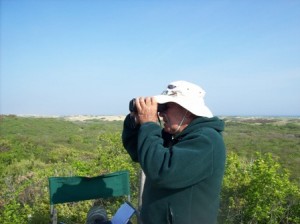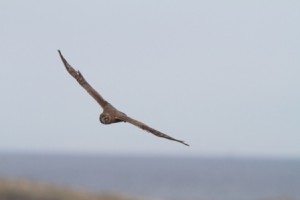For nearly 15 springs, Don Manchester has manned a post at Pilgrim Heights in North Truro to count the raptors migrating north along the Outer Cape shoreline. It can be a lot of counting: in 2010, Don and a few assisting volunteers spotted nearly 2700 birds. That record year included 14 black vultures, 21 bald eagles and 9 Mississippi kites.
With permission from the Cape Cod National Seashore, Don mans the Hawk Watch site from March through June. So far, he says, this spring’s migration has been disappointing—only about 750 raptors as of this posting. Don says it’s all about wind direction: the more days with a southwest breeze, the more migrants that can be seen and counted. This year, he says, there were a lot of days where the wind was out of the northeast. Don and Wellfleet Bay’s numbers are reported to the Hawk Migration Association of North America. The long-term, consistent data are valuable to gauging changes in the populations of these species.
Science coordinator Mark Faherty notes the Pilgrim Heights site is only one of many data points for North American hawk counting. But over the years, a few trends have emerged.
“We’ve seen increases in kestrels (puzzlingly, because their numbers along the east coast have been falling), ospreys (expected), red-shouldered hawks (rapidly increasing breeder in eastern Mass as far as the Upper Cape), and a startling decline in northern harriers,” Mark says.
As Don says in this video, the vast majority of the birds seen at Pilgrim Heights are young birds, not ready to breed, and traveling a bit off course.
Wellfleet Bay is always looking for volunteers to help Don record hawk numbers or to provide information to passing visitors so he can focus on the skies. If you’re looking to improve your birding skills and you’d enjoy doing it in a breathtaking location, consider spending a couple of hours a week with the Hawk Watch project. Contact Diane Silverstein if you’re willing to help.
Click here to find directions to the Hawk Watch.




